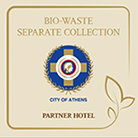
The Acropolis of Athens is an ancient citadel located on a rocky outcrop above the city of Athens and contains the remains of several ancient buildings of great architectural and historic significance, the most famous being the Parthenon. The word acropolis is from the Greek words ἄκρον and πόλις (akron and polis)

Also called the Hill of the Muses, Filopappou Hill - along with the Hills of the Pnyx and the Nymphs - was, according to Plutarch, where Theseus and the Amazons did battle. Inhabited from prehistoric times to the post-Byzantine era, today the pine-clad slopes are a relaxing place for a stroll. They offer excellent views of Attica and the Saronic Gulf, well-signed ruins and some of the very best vantage points for photographing the Acropolis.

Thiseio is popular for early afternoon or evening strolls with views of the illuminated Acropolis. It includes the pedestrianized Apostolou Pavlou street that rings the Acropolis. The National Observatory, a scientific institute for the study of astronomy and seismology has vintage telescopes on display and offers tours, while the Herakleidon museum hosts art and science exhibitions.

In the shadow of the Acropolis and its ancient temples, hillside Plaka has a village feel, with narrow cobblestone streets lined with tiny shops selling jewelry, clothes and local ceramics. Sidewalk cafes and family-run tavernas stay open until late, and Cine Paris shows classic movies al fresco. Do not miss, one of the most idyllic neighborhoods in Plaka, Anafiotika. The picturesque whitewashed houses and narrow alleys are reminiscent of a Cyclade island village, called Anafi.

It is the central, most important square of Athens from both a historical and social point of view, at the heart of commercial activity and Greek politics. The square is named after the Constitution that King Otto was obliged to grant after a popular and military uprising on 3 September 1843. It is located in front of the 19th-century Old Royal Palace, housing the Greek Parliament since 1934.

The Stavros Niarchos Foundation Cultural Center, SNFCC is a public space open to everyone. It has been a hive of cultural, educational, athletic, environmental and entrepreneurial activity that is constantly evolving. It includes the Greek National Opera, the National Library of Greece as well as the Stavros Niarchos Park, one of the largest green areas in Athens, covering 21 hectares.

The Onassis Cultural Centre-Athens was inaugurated in December 2010, as a new cultural site accessible to all. Its mission is the promotion of modern cultural expression, the support of new Greek artists, the cultivation of international collaborations, the education and lifelong learning, as well as the co-existence and interaction of sciences, innovation and arts.

The Theatre of Dionysus is regarded as the first sample of Greek theatres and the birthplace of the Greek drama. It was built into a natural hallow at the southern slopes of the Acropolis and it is the first theater in the world. This ancient theater was dedicated to Dionysus, the god of wine making and ecstasy, whose festivals was the driving force behind the development of Greek theater. Probably established in the late 6th century, the theater has been reconstructed many times since then.

Ermou street is a commercial, pedestrian only street, connecting Kerameikos archaeological site with the Syntagma Square through Monastiraki, Psiri and Thiseio.

Attica City Link is the largest and most fashionable department store in Greece, housed in a historically preserved, neo classical building. Since the beginning of its operation in 2005, Attica City Link has become synonymous to a unique shopping experience hosting more than 850 brands.









